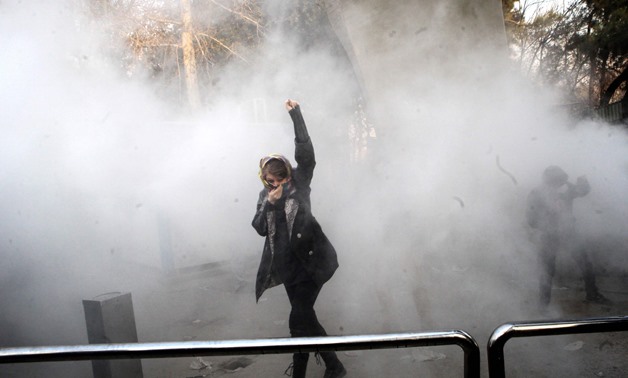
An Iranian woman raises her fist amid the smoke of tear gas at the University of Tehran during a protest driven by anger over economic problems, in the capital Tehran on December 30, 2017- AFP.
CAIRO – 31 December 2017: As the protests of Iranian people enter its fourth day in a row, the Iranians found themselves standing alone in the face of a corrupt oppressive regime. The regime has done everything it could to stop the demonstrations; two protesters have already been killed after clashes broke out with security forces.
In the face of the demonstrations, the world has fallen silent, ignoring the legitimate demands of protesters for a prosperous life for all Iranians and a democratic, pre-Islamic revolution regime. Some of major media outlets in the U.S. pictured the protests as economic anxiety, but that is not what the people of Iran have been chanting against for the past three days. They chant, "Death to the dictator,” “We do not want an Islamic republic,” “Death to Khamenei” and “Death to Hezbollah.” Those chants are not a sign of a stumbling economy, or a cry for economic prosperity, they are chants of oppressed people, thirsty for democracy under a regime that prosecutes opposition activists. It is a regime that systematically fabricates accusations against individuals and groups to consolidate power and curb opposition and diversity.
When the second term of President Hassan Rouhani began in May, he pledged to resume his efforts for a new open-up-to-the-world Iran. He promised of reviving the economy following the 2015 nuclear deal with the United States and five other countries, which eased the sanctions on Iran in exchange for curbing nuclear activities. It was a deal that the Obama administration considered as a victory for diplomatic efforts. Rouhani also took this deal as a breakthrough for economic recovery after decades of sanctions.

Representatives of the P5+1 and the Islamic Republic of Iran at the historic nuclear agreement sealed in Vienna – UNIS Vienna
Rouhani’s dreams did not come to fruition due to the rooted corruption in his regime and his broken banking system, not to mention replacing the administration of Obama with the iron-fisted administration of Trump. The Trump administration threatened to rip up the deal two months ago due to its “flaws” and to impose further sanctions on Iran’s Islamic Revolutionary Guard Corps (IRGC) as a backer of terrorist groups in the region, in reference to Hamas and Hezbollah.
Earlier this month, Rouhani submitted a $337 billion draft budget to Parliament that allocated about $100 billion for public service reform programs that would create jobs for the youths. The draft budget also proposed reformation in the banking system and introduced a new social security program. The reforms Rouhani seeks came with a price, since it proposed slashing cash subsidies to the poor and increasing fuel prices, which resulted in a price hike on everyday products for people.
What provoked public the most was imposing those painful economic reforms, while the Iranian regime pours billions of dollars to fund the terrorist organizations in the regions, Hamas in Palestine, Hezbollah in Lebanon and Houthis in Yemen, and to fund its proxy wars in multiple countries.
The Iranian Government met the protesters demands with violence, it arrested dozens of citizens, killed two individuals and threatened those in the streets, demanding they end the demonstrations and return home.

People protest in Tehran, Iran December 30, 2017 in in this picture obtained from social media. REUTERS. THIS IMAGE HAS BEEN SUPPLIED BY A THIRD PARTY
"Those who damage public property, disrupt order and break the law must be responsible for their behavior and pay the price," Interior Minister, Abdolrahman Rahmani Fazli, said on state television early Sunday.
This is the biggest unrest in the country since the uprising of 2009, where demonstrators took to streets to protest against the corrupt voting system that brought former President Mahmoud Ahmedinejad to the office, but this time their demands are social and, to a lesser extent, economic.

People protest in Tehran, Iran December 30, 2017 in this still image from a video obtained by REUTERS. THIS IMAGE HAS BEEN SUPPLIED BY A THIRD PARTY – REUTERS.
While the Trump Administration strongly backed the demands of the Iranian people, other world leaders preferred to watch mutely, waiting to see what will come of the protests.
U.S. President Donald Trump tweeted a supportive message to the peaceful protesters of Iran. He recalled his speech at the United Nations General Assembly (UNGA) through his official Twitter account, “The entire world understands that the good people of Iran want change, and, other than the vast military power of the United States, that is what Iran’s people are asking and what their leaders fear the most.”
He later tweeted:
The Iranian uprising should receive more support from the world, especially Arab nations, who suffered the most from the interference of the Iranian regime in their domestic affairs.
This past summer, four Arab nations, Bahrain, Egypt, Saudi Arabia and the UAE, severed their ties with Qatar, and one of the most obvious reasons was the Iranian-Qatari rapprochement, accusing Qatar of implementing the Iranian agenda in the region, by funding the terrorists who target nations’ peace. In light of this, this uprising may force the Iranian regime to implement more reforms, give democracy to their people and direct the country’s wealth to revive the economy, not to spend them on the welfare of terrorists.


Comments
Leave a Comment